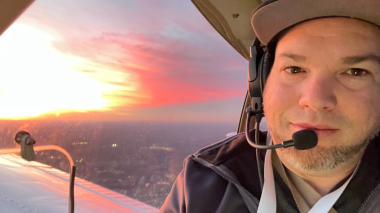Seventy-seven-year-old Robert Lordo didn’t know exactly what was wrong – he just knew he’d never felt worse. He was extremely weak, didn’t feel rested after a night’s sleep and wasn’t able to walk even a few steps without pausing to catch his breath. Soon, he learned the problem: He had severe aortic stenosis.
One of the most common heart valve problems, aortic stenosis happens when the main valve in the heart narrows, causing blood to build up in its main pumping chamber. The result: fatigue, dizziness, persistent coughing and shortness of breath – exactly what Robert experienced.
Fortunately for Robert, an emerging technology known as transcatheter aortic valve replacement – often called TAVR – had his faulty heart valve fixed in no time. Just eight hours after having the minimally invasive procedure, he was out of bed and walking the hospital halls without any shortness of breath.
“It’s like night and day,” he says. “Before, I had trouble walking to the mailbox. Now it’s like I have a whole new heart.” How does TAVR work, and how is it helping patients like Robert? Sanger Heart & Vascular Institute cardiologist Michael Rinaldi, MD, shares more about this technology.
What were patients doing before TAVR came along?
For a long time, open-heart surgery has been the go-to treatment for aortic stenosis. But open-heart surgery can be really tough on the elderly, especially when they have multiple health issues. And being confined to a hospital bed for the long recovery can result in setbacks.
With TAVR, patients have a much easier recovery because it’s so much less invasive.
So, how exactly does TAVR work?
It’s a minimally invasive procedure where doctors put a replacement directly inside the narrowing valve to widen and strengthen it, similar to putting a stent into an artery. Using a catheter (a narrow tube) passed through an artery in the leg, the new valve is guided up to the heart with the help of detailed digital imaging.
Patients are fully awake while it’s done, but they’re sedated so they don’t feel anything. They recover quickly and are back home with their families within a couple of days.
This sounds like it could help a lot of people.
Absolutely. About half a million people in the US are diagnosed with severe aortic stenosis every year. But because it tends to affect older patients, many of them don’t get the treatment they need due to concerns about the complications and long recovery associated with conventional surgical treatment.
Fortunately, that’s been changing since TAVR was approved by the FDA in 2012.
How is TAVR changing lives?
One of the best things about TAVR is that it results in improved heart function almost immediately. That’s really gratifying for patients. They often can get back to their normal routine within a week.
Robert’s case is very typical. He actually has a longer history of heart disease, and Sanger cardiologists had been monitoring his heart for 15 years. Early in 2017, his doctors discovered his aortic valve was narrowing and causing extreme shortness of breath. Today, Robert says he feels like he has a new heart.
At Sanger Heart & Vascular Institute, we recently completed our 500th TAVR procedure. We generally do more than 220 of these cases a year, so we’re a volume leader in our region.
What’s next for TAVR?
TAVR clinical trials are ongoing. Nationally, the positive results from early trials in patients with aortic stenosis have set the stage for further studies.
Here at Sanger, some of our patients are part of a Phase III trial for those whose symptoms are less severe. We’re also participating in trials studying the benefits of TAVR for younger, healthier patients. Since we have the region’s shortest post-TAVR hospital stays and lowest readmission rates for complications, we’re one of a handful of centers in the US chosen to participate in these important trials.
TAVR is poised to keep growing as an alternative, non-surgical option for people with aortic stenosis. At Sanger, we’re hopeful TAVR eventually becomes the standard of care, and we’re positive even more next-generation technologies are on the horizon.



